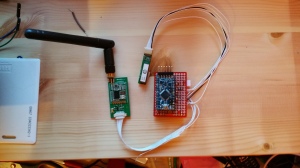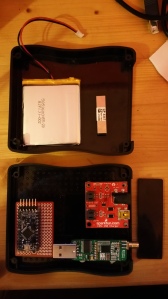D of E Tracker project box component layout…
Here’s some radio project pics for you…
The first one, above, shows the partly soldered project. You can see the battery plug (top right of red solderable breadboard) which will go to my LiPo recharger circuit. You also see the 3DR radio airside module (left) and the mini GP-635T GPS unit (centre).
The aerial you see is the one that comes with the project. This is a WiFi aerial so will be getting replaced. Just waiting on a 433MHz compatible antenna to arrive.
Here you see the project box layout. To the bottom of the picture is the bottom half of the project box. You see the GPS unit in the top part so its antenna doesn’t have a clouded view of the sky.
You also see the battery in the top half. This will be plugged in to the LiPo charging circuit (red, bottom picture, right hand side), which will also have a power cable going to the solderable mini breadboard with the Arduino mounted. (bottom left).
Again the radio (this time the ground side usb module) is mounted at the bottom. I’m investigating whether a short adapter circuit can be used to make use of the ground side module. Ideally I want a UART module like the airside one, but suppliers of the full pair of units give you one of each. (For about GBP 30).
The embedded SoC radio circuit though costs only GBP 2.62 from Mouser!!! So it may work out cheaper to take this, and the open source 3DR radio schematics (zip), and build my own UART on a PCB with this chip mounted.
Design rethinking
Something I’ve noticed is that the extra vertical pins on the Arduino (A4-A7) only just fit in the project box. This is without the non-permanent header block from the first image. I’ll remove the 4 extra analog pins as I’m no longer using them. This will mean I don’t have to solder the Arduino entirely to the breadboard – leaving it removable for use in other projects. (You can see the height of the Arduino in the top image because I use a header block to mount it.)
I may also remove the barrel jack from the LiPo charger to remove the possibility of someone plugging in both this and the USB cable!
I also need to check if the LiPo circuit has a voltage regulator. If so I’ll wire the output directly to the VCC rather than the RAW line of the Arduino. The Arduino’s voltage regulator is well known for being power hungry, so removing this will help overall power consumption.
I’ve toyed with the idea of modifying the LiPo charger to be a 1-2 Amp charger, but most USB sockets don’t support above 500mA so I think its easier to just make people wait 4 hours to recharge the battery and keep the power lower.
In the future I’d like to add a way to download an activity log. I may develop a Bluetooth app for this – but for now I’m happy with a live view of data.


Written
on Fri 26/Dec/2014